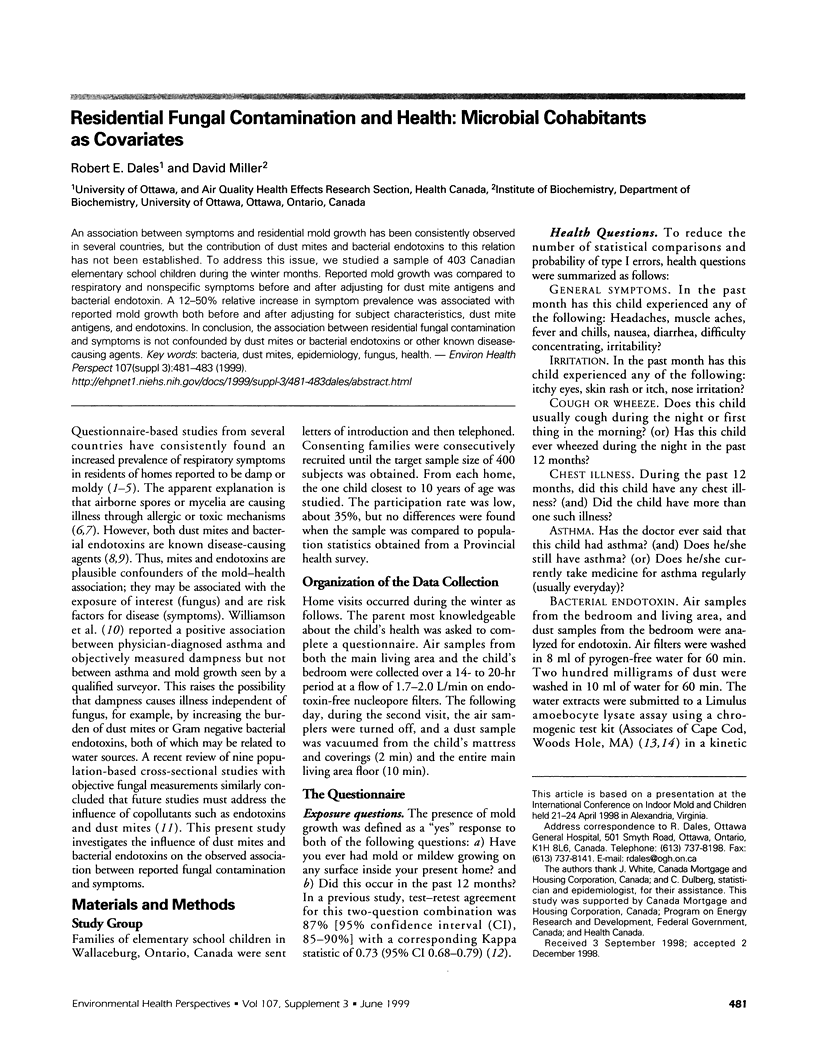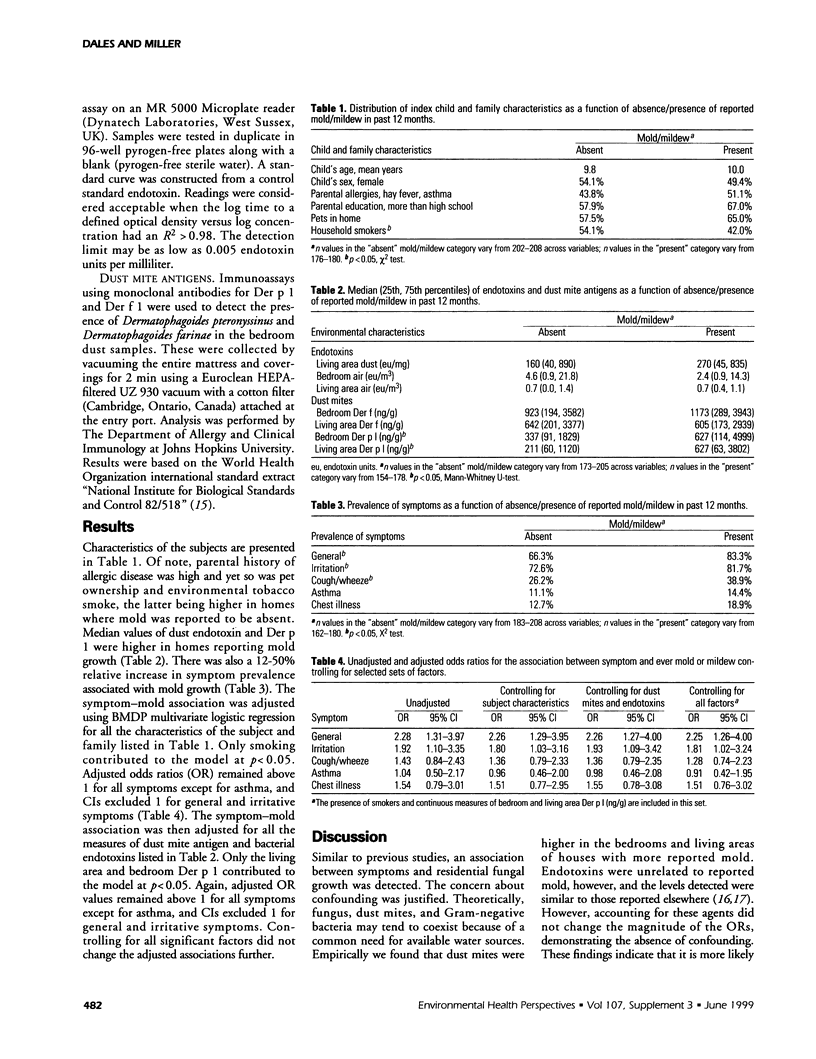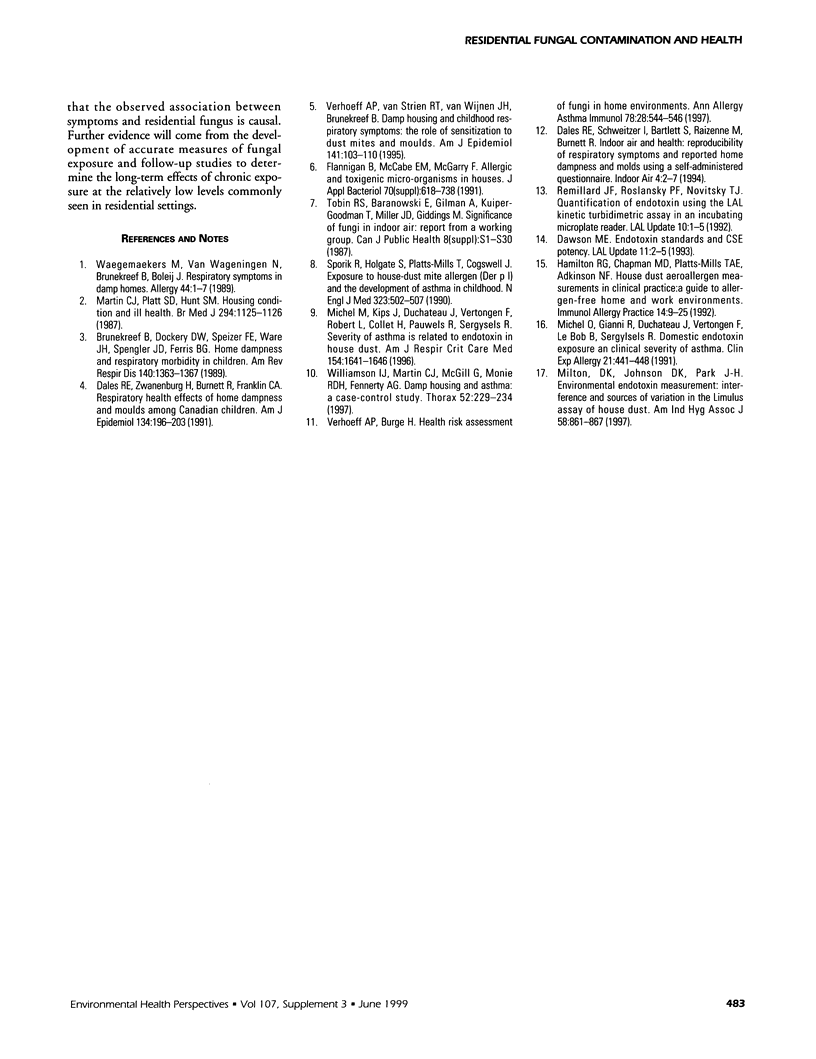Abstract
An association between symptoms and residential mold growth has been consistently observed in several countries, but the contribution of dust mites and bacterial endotoxins to this relation has not been established. To address this issue, we studied a sample of 403 Canadian elementary school children during the winter months. Reported mold growth was compared to respiratory and nonspecific symptoms before and after adjusting for dust mite antigens and bacterial endotoxin. A 12-50% relative increase in symptom prevalence was associated with reported mold growth both before and after adjusting for subject characteristics, dust mite antigens, and endotoxins. In conclusion, the association between residential fungal contamination and symptoms is not confounded by dust mites or bacterial endotoxins or other known disease-causing agents.
Full text
PDF


Selected References
These references are in PubMed. This may not be the complete list of references from this article.
- Brunekreef B., Dockery D. W., Speizer F. E., Ware J. H., Spengler J. D., Ferris B. G. Home dampness and respiratory morbidity in children. Am Rev Respir Dis. 1989 Nov;140(5):1363–1367. doi: 10.1164/ajrccm/140.5.1363. [DOI] [PubMed] [Google Scholar]
- Dales R. E., Zwanenburg H., Burnett R., Franklin C. A. Respiratory health effects of home dampness and molds among Canadian children. Am J Epidemiol. 1991 Jul 15;134(2):196–203. doi: 10.1093/oxfordjournals.aje.a116072. [DOI] [PubMed] [Google Scholar]
- Martin C. J., Platt S. D., Hunt S. M. Housing conditions and ill health. Br Med J (Clin Res Ed) 1987 May 2;294(6580):1125–1127. doi: 10.1136/bmj.294.6580.1125. [DOI] [PMC free article] [PubMed] [Google Scholar]
- Michel O., Ginanni R., Duchateau J., Vertongen F., Le Bon B., Sergysels R. Domestic endotoxin exposure and clinical severity of asthma. Clin Exp Allergy. 1991 Jul;21(4):441–448. doi: 10.1111/j.1365-2222.1991.tb01684.x. [DOI] [PubMed] [Google Scholar]
- Michel O., Kips J., Duchateau J., Vertongen F., Robert L., Collet H., Pauwels R., Sergysels R. Severity of asthma is related to endotoxin in house dust. Am J Respir Crit Care Med. 1996 Dec;154(6 Pt 1):1641–1646. doi: 10.1164/ajrccm.154.6.8970348. [DOI] [PubMed] [Google Scholar]
- Milton D. K., Johnson D. K., Park J. H. Environmental endotoxin measurement: interference and sources of variation in the Limulus assay of house dust. Am Ind Hyg Assoc J. 1997 Dec;58(12):861–867. doi: 10.1080/15428119791012199. [DOI] [PubMed] [Google Scholar]
- Sporik R., Holgate S. T., Platts-Mills T. A., Cogswell J. J. Exposure to house-dust mite allergen (Der p I) and the development of asthma in childhood. A prospective study. N Engl J Med. 1990 Aug 23;323(8):502–507. doi: 10.1056/NEJM199008233230802. [DOI] [PubMed] [Google Scholar]
- Verhoeff A. P., Burge H. A. Health risk assessment of fungi in home environments. Ann Allergy Asthma Immunol. 1997 Jun;78(6):544–556. doi: 10.1016/S1081-1206(10)63214-0. [DOI] [PubMed] [Google Scholar]
- Verhoeff A. P., van Strien R. T., van Wijnen J. H., Brunekreef B. Damp housing and childhood respiratory symptoms: the role of sensitization to dust mites and molds. Am J Epidemiol. 1995 Jan 15;141(2):103–110. doi: 10.1093/oxfordjournals.aje.a117398. [DOI] [PubMed] [Google Scholar]
- Williamson I. J., Martin C. J., McGill G., Monie R. D., Fennerty A. G. Damp housing and asthma: a case-control study. Thorax. 1997 Mar;52(3):229–234. doi: 10.1136/thx.52.3.229. [DOI] [PMC free article] [PubMed] [Google Scholar]


